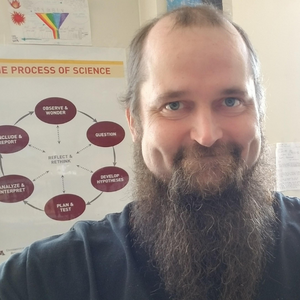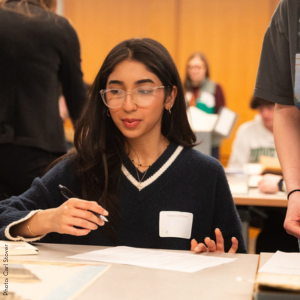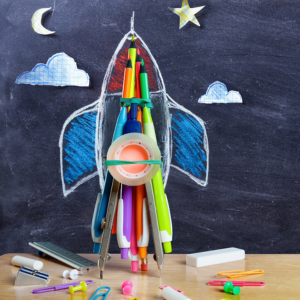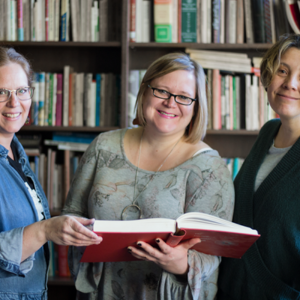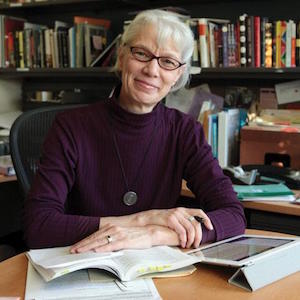The Global Impact of Physics by Inquiry
It’s a familiar scene on any campus: students huddled, hunched around a workstation as they lean forward to better assess their latest experiment. Abandoned backpacks fill the chairs, which are scattered throughout the lab. In the background, a dozen or more two-pan balance scales sit on top of a postered cabinet. One poster reads: “Physics Hall of Fame.”
The course is Physics by Inquiry, a four-credit lab course developed by the Department of Curriculum and Instruction and the College of Education and Human Development at the University of Minnesota. Using universal design, the curriculum encourages students to learn the fundamental concepts of physics by collaborating to perform experiments, then develop theories about how things work. In other words, students work like scientists.
But these aren’t college students, and the campus is not that of UMN, but South High School in Minneapolis. Even so, the students who successfully complete Physics by Inquiry can earn college credit without ever leaving South’s classrooms thanks to College in the Schools (CIS), a nationally accredited, concurrent enrollment program offered by the UMN Twin Cities.
Opportunity, Challenge, and Reward
For students, CIS offers far more than a chance to earn college credit while in high school. It expands access to challenging college-level courses that boost confidence and which have proven to amplify students’ college and career trajectories. Best yet, CIS courses are free to all concurrent enrollment students in Minnesota because of the PSEO Act, a Minnesota state statute that is unique in the United States.
CIS instructors are also well-served. University faculty-led professional development workshops offer the time and space for instructors to continue studies in their professional disciplines, which enriches the classroom experience. The impact is significant.
"The work I do has me collaborating with University faculty and impacting more than 10,000 students and 400 teachers each year.”
"The work I do has me collaborating with University faculty and impacting more than 10,000 students and 400 teachers each year,” says Program Director Emily Hanson who, fittingly, is a CIS alumna.
And the proof, as they say, is in the pudding—or in this case, the most recent program statistics: CIS currently offers 41 courses from five University academic departments. In 2020−21, more than 8,967 students earned 48,568 UMN credits in courses offered by 387 teachers in 124 high schools. What’s more, 17% of the freshmen who enrolled at the University in fall 2021 were former CIS participants.
Of Application and Theory
Randy Hedlund has been teaching Physics by Inquiry at South for close to a decade. Increasingly popular, the course started with one section of 14 students in 2014 and currently has five sections that serve a total of 120 students. Hedlund teaches all five sections—happily.
The physics and biology teacher first heard about CIS prior to working at South. Learning that students would receive free tuition, and recognizing the district’s growing population of first-generation college students, sealed the deal for him. “The support for CIS is one of the main reasons I chose to go to South… I knew the opportunity would be ideal for our students.”
And ideal for him and his colleagues as well. Through CIS "you get to work with an incredible team of teachers and U of M professors… and they understand how science is an ever-changing process where we are still discovering," says Hedlund.
Associate Professor Bhaskar Upadhyay has been the UMN faculty coordinator of Physics by Inquiry since 2018. A former K–12 teacher, he now finds his work addresses issues of "science teaching and learning in high-poverty urban schools" and how social justice and equity can be achieved through science education. Upadhyay’s current research focuses on teaching science, including physics, in a more engaging way so students better understand the discipline and include it in their everyday activities. This is something that seems to be playing out in Hedlund’s classes.
"CIS has really changed the way I teach and made me more confident in inquiry education... Discovery takes time, but it is more meaningful, and students understand things more deeply.“
"CIS has really changed the way I teach and made me more confident in inquiry education,” says Hedlund. “At first I was like ‘you all need to know this, so I am going to tell you how it works.’ …Inquiry basically has the students lay out their models and predictions, then revise them. Discovery takes time, but it is more meaningful, and students understand things more deeply.“
Sharing the Light (and the Love)
At the end of the 2022 school year, Hedlund asked his students which project made them most proud. The resounding response was We Share Solar, in large part due to a feeling of global citizenship and making a difference in the lives of others.
“Typically in class, everything that we do is to extend our knowledge, but in this case, while learning, we get to create something that other people will be using to learn,” wrote Ally, a CIS scholar.
We Share Solar is a nonprofit education program that marries hands-on practical engineering skills with real-world applications. “Trained teachers cultivate students’ interest in STEM subjects and inspire them to meet an immediate need in the developing world.”
For students in Physics by Inquiry, the project involved building Solar Suitcases (12-volt DC stand-alone solar systems) which will be distributed to energy-scarce refugee camps and rural schools in East Africa and Nepal.
According to We Share Solar cofounder Hal Aronson, the program "serves youth twice, first as an educational experience for American youth and second as a renewable power and lighting system for youth in parts of the world that lack electricity."
"I am glad we participated," says Hedlund. Assembling the solar circuit suitcases helped students hone their problem-solving skills… and they followed the three pillars of sustainability (economics, social justice, and environment). They learned persistence. Some discovered they had mechanical skills. Some were amazing artists as they designed the boxes. They all loved that they were bringing sustainable energy to East Africa and Nepal. They did tons of teaching and learning together. Sustainability, collaborating, and making a positive change are all part of science as well.”
Teamwork and creativity were also favored aspects of the project. The students decorated the suitcases and wrote personal letters to the recipients, hoping to receive letters in return.
“Being able to use my hands to make something that will actually help people was very fun. We get to work with our hands a lot in this class… and I got to see how all the things went together,” shared CIS scholar Alex.
And in an inadvertent nod to the mission of College in the Schools and Physics by Inquiry (not to mention the enthusiastic work of teachers such as Hedlund and Bhaskar), Alex adds, “I was already thinking about becoming an electrical engineer, but this definitely made me more certain."
Learn More
Photos courtesy South High School and We Share Solar

